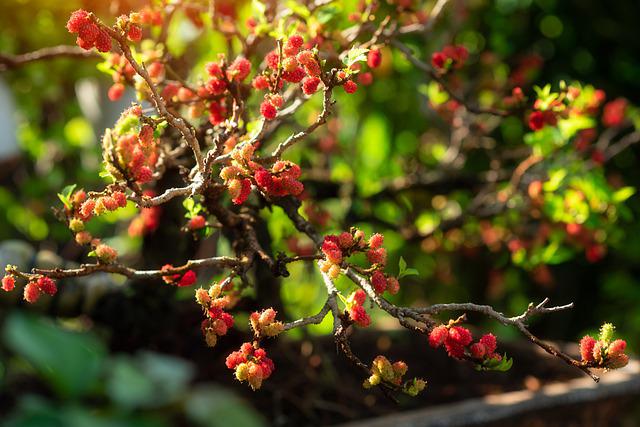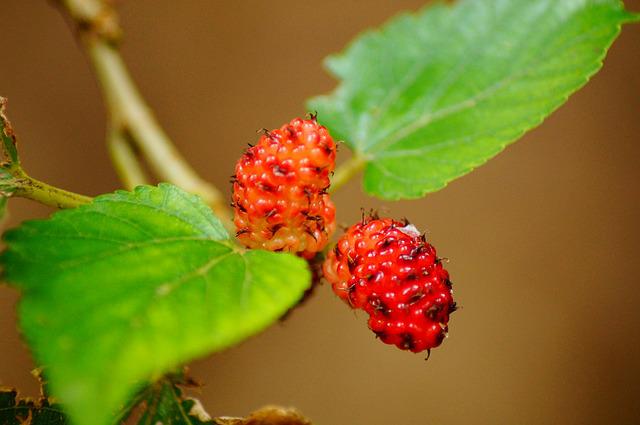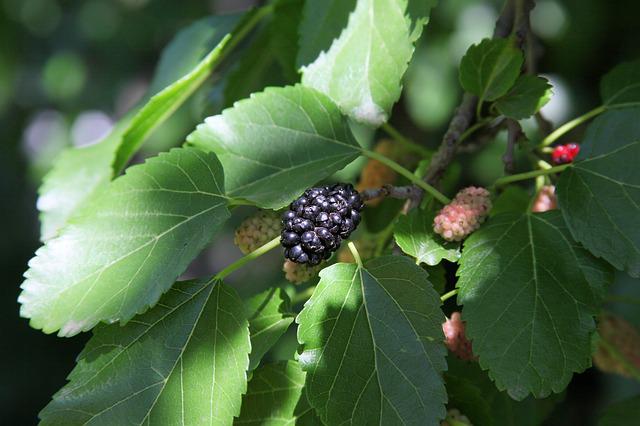Do Mulberry Trees Bloom? Interesting Facts About Mulberry Flowers

Mulberry trees do bloom. They flower during spring. The flowers of a mulberry tree are small groups of tiny white or green flowers that grow on small, short spike clusters called “catkins.” The male flowers are longer and narrower. A mulberry tree can have both male and female flowers, or it can only have male or female flowers. However, only the female flowers produce fruit. After blooming in May, mulberry flowers turn into berries, a group of tiny fruits with seeds.
Table of Contents
The Mulberry Blossom
The male and female flowers of the mulberry tree are called catkins. Male catkins are about 3/4 to 2 inches (2 to 5 cm) long and have a yellowish-green color. The female catkins are smaller, oval, and green with white “hairs.”
Red Mulberry Flower
In April and May, tiny greenish catkins of the red mulberry flower appear. This plant has small tubular flowers that can reach a length of up to one inch (2.5 centimeters).
Black Mulberry Flower
Catkins of black mulberry flowers are small, tubular white flowers. This tree puts on its spring blooms every year. Summer is when the berries begin to appear and ripen.
White Mulberry Flower
In early spring, yellow-green catkins hang down. Some white mulberry trees only have flowers of one sex (called dioecious), while others have flowers of both sexes (called perfect). Fruit can only come from plants with female flowers. The half-inch to one-inch-long fruits look like blackberries and turn from white or pink to dark purple before falling off mid-summer.
How to Know Whether a Mulberry Tree Is Male or Female
Mulberry trees (Morus spp.) are species that can switch between being male and female and back again. Some mulberry trees are dioecious, which means they have either only male flowers or only female flowers. But right next to this kind of tree could be a monoecious one, which has both male and female flowers on the same plant. And to add another layer of mystery, mulberry flowers can sometimes start as one sex but change halfway through the season.

What Mulberry Tree Gender Means
For many species, being male or female is a full-time job. It can affect what you wear in humans, what sports teams you can join, and even how much money you can make. Male birds often have brighter feathers than their female counterparts, and only male moose have racks.
However, when it comes to mulberry trees, the flower is the only part of the plant with gender. A mulberry tree is called male if it has male flowers that contain the pollen that female flowers need to make fruit. A tree is called female if all of its flowers are female and have a stigma that collects pollen and a way for the pollen to get to the ovary at the tree’s base. The terms “male tree” and “female tree” don’t apply to trees with both male and female flowers or trees whose flowers can change from one sex to another.
That means that those mulberry trees with all-male flowers are male, at least for now. And those mulberry trees with only female flowers are female. A lot of mulberry trees are neither of those things.
Flower Gender
Even though mulberry trees might not always be male or female, every mulberry flower has a gender that you can tell at a given time, even if that gender might change. Small mulberry flowers grow in clusters called “catkins” that hang down. The flowers of each of the three kinds of mulberry look slightly different. The flowers of the black mulberry (Morus nigra) look like small, green catkins with spikes. The red mulberry (Morus rubra) has light green catkins, and the white mulberry (Morus alba) has small green spikes.
But the male flowers of each type of mulberry are the same in how they work. The four reproductive parts of a male mulberry flower are called stamens, and they sit on stems called filaments. A female flower has one organ for reproduction, called a pistil, attached to a style that looks like a thread. The pollen gets on the stigma on the pistil, and the style guides it to the ovary at its base.
Can you see these organs in flowers that are so small? Maybe, if you look closely at a flower with a magnifying glass. The flower is male if you see a filament, which looks like a very thin stem. If the flower doesn’t have a stem-like growth, it is a female flower. But the length of the flower catkins is a better way to tell if a plant is male or female. Male catkins can get up to 2 inches long and are narrow, while female catkins can only get as long as 1 inch and are wider.
Tips for Getting a Mulberry to Bloom
The mulberry tree’s flowers aren’t very appealing, and the fruits are messy and useless unless you plan to make jams, jellies, or other foods. As long as it gets plenty of sunlight, water, and fertilizer, it will bloom and produce fruit without much effort from the owner.
Mulberry trees rarely bloom or bear fruit due to a lack of soil nutrients or a late spring frost killing the flower buds, respectively.
Catkins, which are clusters of single-sex flowers with no petals, are the tree’s primary method of pollination. Catkins of both sexes are often found on the same tree. Generally speaking, male catkins are about 1 inch (2.5 cm) long, while female catkins are about half that length. 5 Produced in large quantities, the fruit is blackberry-like. White is the most common color, but it can also turn pinkish-violent from time to time. When unripe, the berries are poisonous to humans because of a chemical called latex, but they are a delectable treat when they are. There are usually white mulberry fruits ready to be harvested in the spring. Although they are sweet, they lack the tartness of the black mulberry, a closely related fruit, which is sweet and tart.
Dioecious plants produce separate sets of male and female flowers known as catkins, which emerge from buds along 1-year-old branches simultaneously as the leaves. There are four stamens in each of the male catkins’ three to four-inch-long, green-to-yellow flower clusters.
An oval or short-cylindric female catkin can reach a length of 34 inches and have an ovary that is slightly flattened and green in color, with a whitish to reddish 2-parted style. Hairy stalks are found on both male and female catkins.
Trees of the mulberry genus are either dioecious or monoecious, though they can alternate between the sexes. Catkins, which appear in the axils of the current season’s growth and on the spurs of older wood, hold the flowers green, pendulous, and unmarked. Some cultivars can produce fruit without any pollination at all. No need for cross-pollination here. Mulberries produce fruit in California without the aid of pollination.

Pollination
Commercial mulberry trees are typically grown from cuttings taken from a mother tree. A few varieties of mulberries are both monoecious and dioecious (male and female flowers on the same tree) (male and female flowers on different trees). On the other hand, Monoecious black mulberries only require one plant to bear fruit. The wind is the only means of pollination for these kinds of flowers.
Harvesting
It is easier to harvest black mulberry trees than any other variety because they are smaller and can be trained into a bush-like shape. Once the fruit has softened and turned the color of blackberries, remove it by hand. Alternatively, they can be harvested by placing a sheet or tarp under the tree and shakily shaking it to release the ripe fruit. Once you’ve picked the fruit, it’s best to store it in the refrigerator and use it within a few days.
